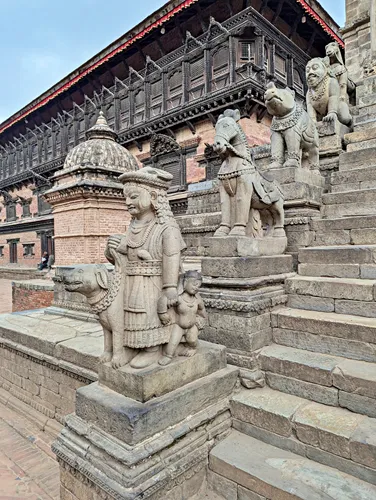Siddhi Laxmi & Shankharnarayan Temples: Your Guide to Bhaktapur's Sacred Sites - Nepal Purple Travel Guide
(map, reviews)
This is Premium Content! To access it, please download our
Backpack and Snorkel Purple Travel GuideLocated directly east of the Palace of 55 Windows is Siddhi Laxmi Temple, which is also spelled as Siddhi Lakshmi Temple.
This temple has a stairway with a unique arrangement of stairway guardian figures that sets Siddhi Laxmi Temple apart from almost every other temple in the Kathmandu Valley. Such stairway guardian figures in Nepal usually follow a more standard pattern (like lions, elephants, or mythical beasts), but this temple defies expectations - making it a rare and important example of symbolic storytelling in stone.


Here at Backpack and Snorkel Travel Guides, we typically promote self-guided walking tours.
But we realize that not everybody likes to walk by themselves in a foreign city. So, just in case that you rather go with ab guide: NO PROBLEM! Please see the Viator tours below.
free GuruWalk tours
paid Viator tours
Origin of the Name Siddhi Lakshmi Temple
The name ‘Siddhi Laxmi’ combines:
'Siddhi' meaning spiritual perfection or attainment
'Laxmi' the goddess of abundance.
Together, it reflects a form of the goddess that grants both material prosperity and spiritual power.
Spiritual Significance of Siddhi Lakshmi Temple
The temple is dedicated to Goddess Siddhi Laxmi, a fierce tantric form of Lakshmi, the Hindu goddess of wealth, prosperity, and power. Unlike the more serene depictions of Lakshmi found in other temples, Siddhi Laxmi is worshipped here in a protective and powerful aspect, believed to guard the city and the royal lineage.
Its placement near the 55-Window Palace suggests that it may have been a royal family’s protective shrine, linking divine guardianship with royal power.
Historic and Architectural Significance of Siddhi Lakshmi Temple
Built in the 17th century, Siddhi Laxmi Temple is a stunning example of stone architecture in Newar style. Its multi-tiered design is guarded by one of the most unusual stairway processions in Nepal:
At the base: A human figure holding a child, with a dog by their side — often interpreted as a symbol of domestic life, fertility, and loyalty.
Above them: A pair of horses – representing speed, energy, and movement.
Then: Rhinoceroses – symbols of strength and endurance, and rare in temple architecture.
Followed by: Human-faced creatures – sometimes interpreted as mythological guardians or tantric beings.
And finally at the top: A pair of camels – the most unusual of the group, possibly indicating exotic power, foreign influence, or tantric symbolism. Camels are not native to Nepal, which adds mystery to their presence.
These guardians symbolize strength, protection, and cosmic balance. The presence of camels is rare in Nepali art, and adds a layer of mystery, possibly referencing distant cultural influences.
Shankharnarayan Temple
Standing directly west of Siddhi Lakshmi Temple, and directly in front of the Palace of 55 Windows is Shankharnarayan Temple.

Origin of the Name Shankharnarayan Temple
The name Shankharnarayan is a combination of:
'Shankha' – the conch shell, a sacred emblem associated with Lord Vishnu
'Nārāyaṇa' – another name for Vishnu, the Hindu protector god
So, Shankharnarayan refers to Vishnu in his conch-bearing form, often depicted holding a shankha (conch), chakra (discus), gada (mace), and padma (lotus). This particular form emphasizes his cosmic presence and divine sound, believed to protect the universe and purify the environment.
Historic and Architectural Significance of
The shrine is believed to have been built in the 17th century, during the Malla period, but the exact date of its construction is not definitively recorded.
It is built in traditional Newar stone architecture with domed roof and detailed carvings.
In front of the temple is a pair of stone lions that serve as dvarapalas or temple guardians, symbolizing strength and protection.
Back to your self-guided tour
Author: Rudy at Backpack and Snorkel
Bio: Owner of Backpack and Snorkel Travel Guides. We create in-depth guides to help you plan unforgettable vacations around the world.
Other popular Purple Travel Guides you may be interested in:
Like this Backpack and Snorkel Purple Travel Guide? Pin these for later:





